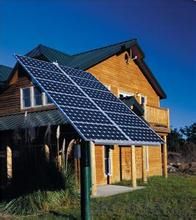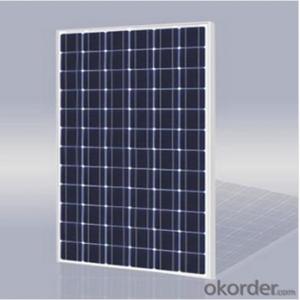570w A Grade Poly Solar Panel 290w with Cheapest Price
- Loading Port:
- Shanghai
- Payment Terms:
- TT OR LC
- Min Order Qty:
- 100 watt
- Supply Capability:
- 50000 watt/month
OKorder Service Pledge
OKorder Financial Service
You Might Also Like
Specification
Poly Solar Panel 290W A Grade with Cheapest Price
Product description
60 cell multi-crystalline solar module. 40mm natural anodised frame. IP65 rated Jbox, 1m solar cable and a pair of MC4 connectors.TÜV SÜD,SABS ISO 9001:2008 certified.
Nominal voltage refers to the voltage of the battery that the module is best suited to charge; this is a leftover term from the days when solar modules were only used to charge batteries. The actual voltage output of the module changes as lighting, temperature and load conditions change, so there is never one specific voltage at which the module operates. Nominal voltage allows users, at a glance, to make sure the module is compatible with a given system.
Open circuit voltage or VOC is the maximum voltage that the module can produce when not connected to an electrical circuit or system. VOC can be measured with a meter directly on an illuminated module's terminals or on its disconnected cable.
Solar panel conversion efficiency, typically in the 20 percent range, is reduced by dust, grime, pollen, and other particulates that accumulate on the solar panel. "A dirty solar panel can reduce its power capabilities by up to 30 percent in high dust/pollen or desert areas", says Seamus Curran, associate professor of physics at the University of Houston and director of the Institute for NanoEnergy, which specializes in the design, engineering, and assembly of nanostructures.[16]
Application
Industrial
Commercial
Residential
Product feather
solar panel refers to a panel designed to absorb the sun's rays as a source of energy for generating electricity or heating.
A photovoltaic (in short PV) module is a packaged, connected assembly of typically 6×10 solar cells. Solar Photovoltaic panels constitute the solar array of a photovoltaic system that generates and supplies solar electricityin commercial and residential applications. Each module is rated by its DC output power under standard test conditions, and typically ranges from 100 to 365 watts. The efficiency of a module determines the area of a module given the same rated output – an 8% efficient 230 watt module will have twice the area of a 16% efficient 230 watt module. There are a few solar panels available that are exceeding 19% efficiency. A single solar module can produce only a limited amount of power; most installations contain multiple modules. A photovoltaic system typically includes a panel or an array of solar modules, a solar inverter, and sometimes a battery and/or solar tracker and interconnection wiring.
Packaging
24-26pcs into carton 312pcs for 20 foot container 712pcs for 40 foot container.
- Q: Can solar panels be installed on theme parks or amusement parks?
- Yes, solar panels can indeed be installed on theme parks or amusement parks. In fact, many parks around the world have already embraced solar energy as a sustainable and cost-effective solution for their energy needs. The large open spaces, rooftops, and car parking areas found in theme parks provide ample opportunities for solar panel installation. By harnessing the power of the sun, parks can reduce their carbon footprint, lower energy costs, and promote environmental consciousness.
- Q: If a solar panel has a power rate of 80 Watts and efficiency of lets say 30%. Does that mean the maximum power this solar panel can generate is (30/00)*80=54 Watts or its just 80 Watts?
- If it says STC or Standard Test Conditions on the nameplate or documentation, then that means 80 watts under bright sun at an unrealistically cool temperature. It is rare to see that power in real life, except when the perfect storm of conditions come together. There is also a PTC rating for some panels, which is more realistic. If the panel does not say STC or PTC, the manufacturer is free to make up whatever test they feel like, which generally leads to ridiculously overstated power. As for efficiency, for residential panels, that's generally only of academic interest. A 80-watt panel is 80 watts, regardless of the efficiency. A more efficient panel will take up slightly less space, but most people are more interested in the total price, since roof space is generally not an issue.
- Q: What direction do solar panels usually point? North? East? South? West?
- I can't believe how many people posted wrong answers to this. Where are they looking? What are they thinking? In the northern hemisphere, solar panels are ALWAYS oriented due south. In the southern hemisphere, face them due north. I am typing on a computer that is running on a solar electric system that supplies my whole house. Been this way for years. So it works.
- Q: Can solar panels be installed on commercial buildings?
- Yes, solar panels can be installed on commercial buildings. In fact, many businesses and organizations are increasingly opting for solar panel installations to reduce their energy costs and environmental impact. By harnessing sunlight and converting it into electricity, solar panels provide a sustainable and renewable source of power for commercial operations.
- Q: What is the impact of roof pitch on solar panels' efficiency?
- The impact of roof pitch on solar panels' efficiency is significant. The pitch, or angle, of a roof determines how much direct sunlight the panels receive and how effectively they can convert that sunlight into electricity. In general, a roof with a steeper pitch allows for better solar panel performance as it maximizes exposure to sunlight and minimizes shading. However, if the roof pitch is too steep, it can increase wind resistance and make installation more challenging. Therefore, it is crucial to find the optimal balance between roof pitch and solar panel efficiency to ensure optimal energy production.
- Q: im aware i dont fully understand. but with what i do. if P = iv, and current changes with voltage, whats the point of changing either. if in any cicumstance, you end up with the same wattage, how does changing either effect a solar setup. (2v panel vs 24v)thanks in advance. explain in laymans if you can.
- The choice of solar panel voltage comes down more to what the panels will be connected to. You're right that power can remain the same at the different voltages. Higher input (panel) voltages are sometimes used in inverter systems to reduce the effect of voltage draw-down. 2v panels (about 20v open circuit) work well for charging 2v batteries, connected in parallel, through a charge controller. For use of a grid-tie inverter, higher input voltages are sometimes used to reduce the effects of draw-down. You want to select and wire (parallel vs. series) your panels based on the input voltage requirement of the load, whatever it may be.
- Q: i took some solar yard lights apart and put them together in a series. i was told if you take AMPS times VOLTS = WATTS. do you test it with ac volt or dc volts? I tested mine with dc volts and got 4 volts in good sun and had my meter set on Ma or milliamps and got .83 which i am asuming that is .83 of one amp now i took those and multiplied .83 times 4 volts to = 34.03 watts. Is this large enough to charge a car battery in a day? And doese it make a difference for amps on how fast it charges or watts. i also was looking around and found 30 watt panels but had higher amps. I am very interested in building solar panels but i realize i dont know what i need to do to make shur they are big enough. my panel is only 9inch by 0 inch. It seems weird that i am putting out 4 volts
- A equipment that super could have a max power production of around 2000 watts. i won't be able to declare if it fairly is sufficient to your desires via fact the figures you gave do no longer make experience. right here is why: the quantity of power being ate up at a given time is measured in watts--that's the ability point. To degree how lots electrical energy you utilize you utilize you need to use kilowatt-hours (or watt-hours, yet its greater handy to apply the former). So--in case you utilize a million kilowatt-hour, meaning you have been ingesting power at an favourite. fee of 000 watts (one kilowatt) for a million hour. Now, it may be VERY united statesa. for a house to apply 5,000 kilowatt-hours in a month--that's an exceptionally severe discern. Yor top power utilization could be 5,000 watts. A image voltaic panel equipment with a optimal technique of 2000 watts isn't adequate to power maximum residences. you easily want a minimum of two times that--and so lots greater in case you like to bypass off the grid. besides the shown fact that it must be an excellent investment besides. you are able to use very practically all the means advert that woudlld maximize your mark downs.
- Q: it is just for a simple project, but i am looking for a cheap, low cost, around one to two volts solar panel regulator uld y'all please help?
- investigate Tractor grant... they have been given small, medium and massive. Wal-mart additionally has infants for image voltaic lights... you ought to string them very close jointly to get volts up... i offered an merchandise which you defined as what you will make -- inexpensive fan with a image voltaic panel on it from Wal-mart--- it cools the interior my vehicle on sunny days.
- Q: How does the size of a solar panel affect its performance?
- The size of a solar panel directly affects its performance as it determines the amount of sunlight it can capture and convert into electricity. Generally, larger solar panels have more surface area to absorb sunlight, resulting in higher power output. A larger panel can generate more electricity, making it more efficient and productive than a smaller one. Additionally, larger panels often have more individual solar cells, which further enhances their performance and efficiency.
- Q: Can solar panels be used for powering a data center?
- Yes, solar panels can be used to power a data center. Solar energy can be harnessed and converted into electricity, which can then be used to power the various components of a data center, including servers, cooling systems, and networking equipment. By utilizing solar panels, data centers can reduce their reliance on traditional grid power and lower their carbon footprint. Additionally, advancements in solar technology have made it more efficient and cost-effective, making it a viable option for powering data centers.
Send your message to us
570w A Grade Poly Solar Panel 290w with Cheapest Price
- Loading Port:
- Shanghai
- Payment Terms:
- TT OR LC
- Min Order Qty:
- 100 watt
- Supply Capability:
- 50000 watt/month
OKorder Service Pledge
OKorder Financial Service
Similar products
Hot products
Hot Searches
Related keywords


























